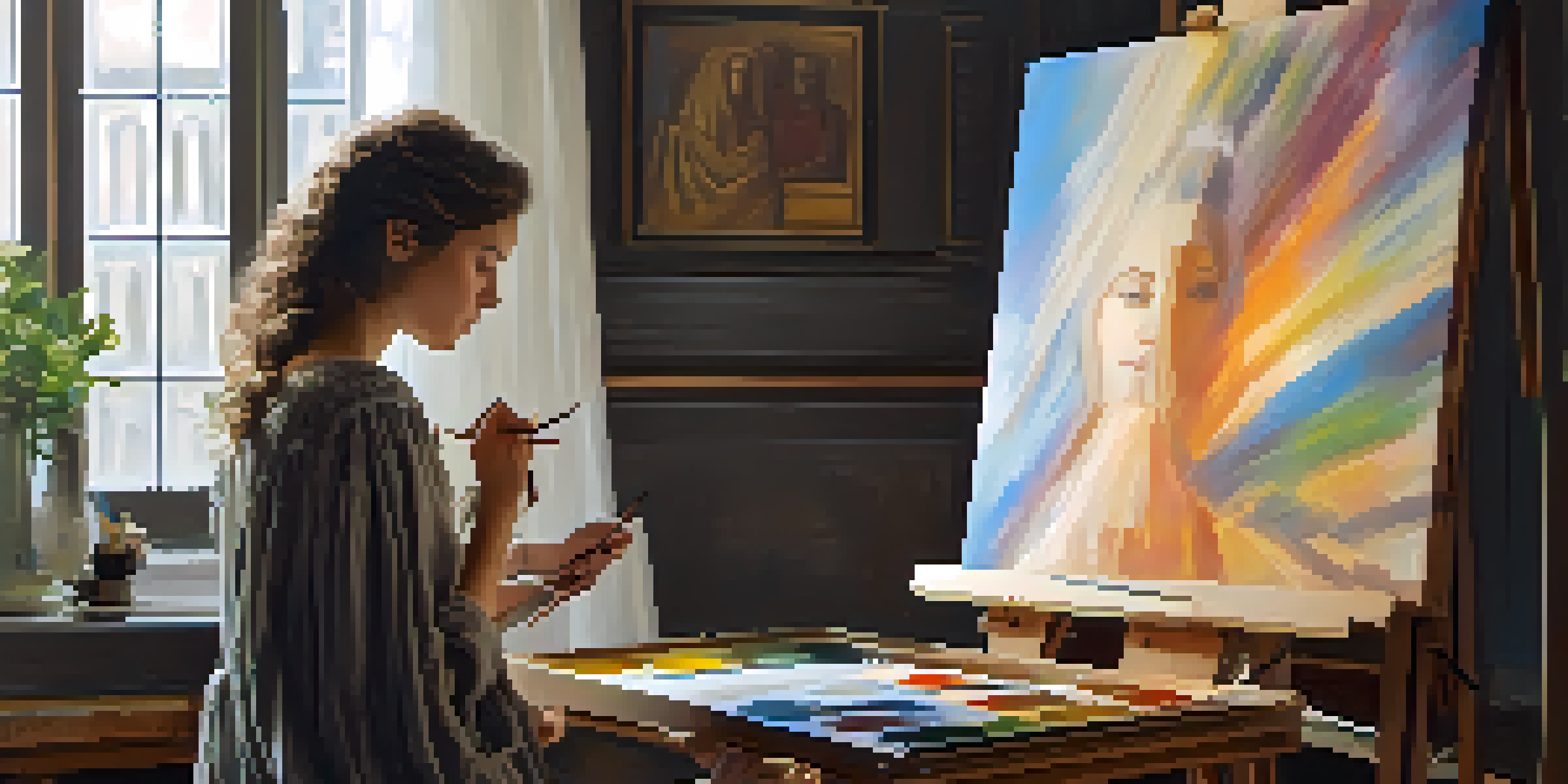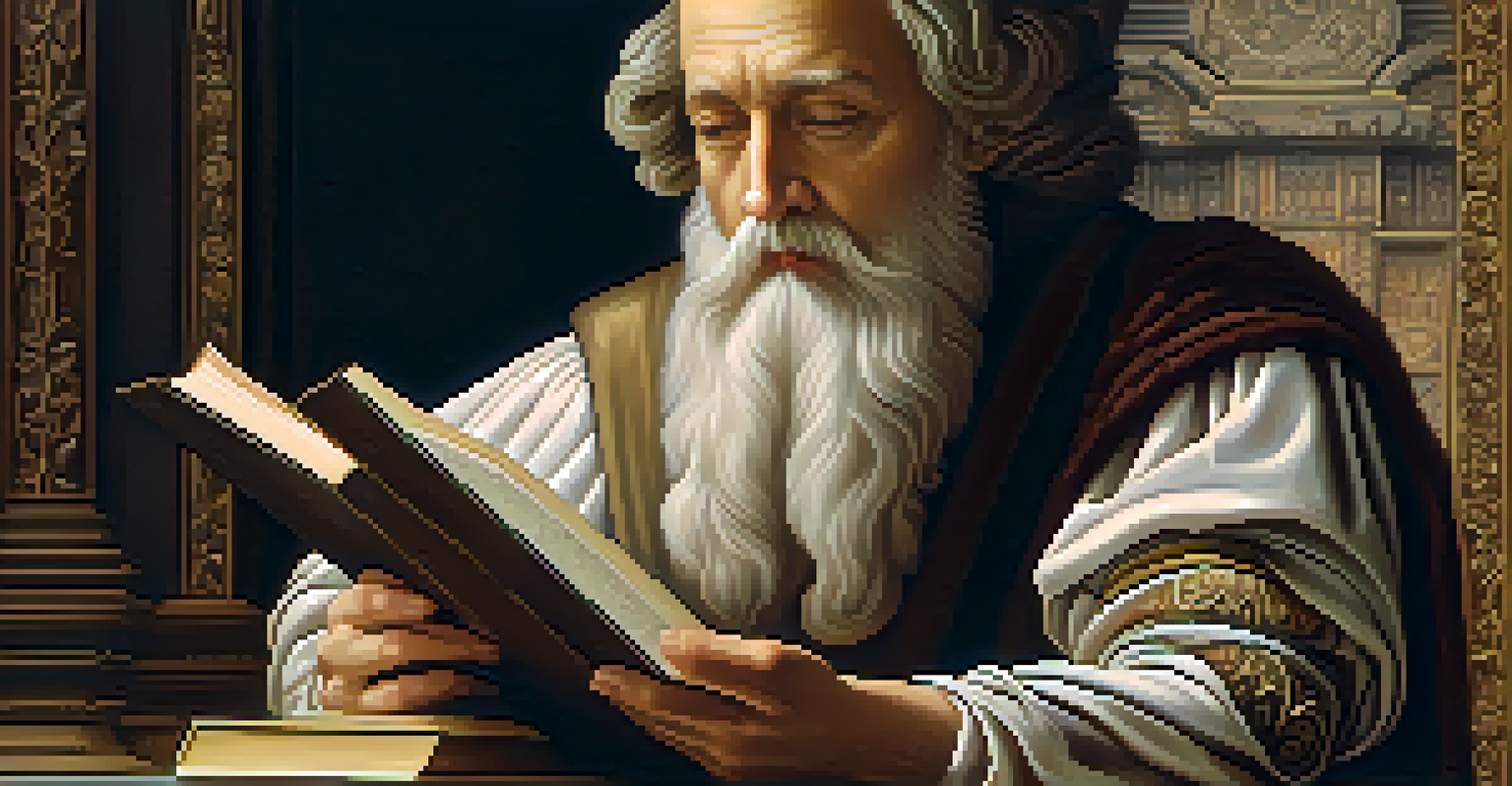Renaissance Art: A Reflection of Cultural Identity and Narratives

Understanding the Renaissance: A Cultural Awakening
The Renaissance, spanning from the 14th to the 17th century, marked a profound cultural rebirth in Europe. This period saw a shift from medieval traditions to a focus on humanism, science, and classical learning. Artists began to explore themes that celebrated individualism and the human experience, reflecting the evolving societal values of the time.
Art is the most beautiful of all lies.
As communities became more engaged with art, the Renaissance also fostered a sense of shared identity among people. Artists like Leonardo da Vinci and Michelangelo not only showcased their skills but also conveyed the collective aspirations and struggles of their societies. This cultural awakening laid the groundwork for future artistic movements, emphasizing the importance of cultural narratives.
Ultimately, the Renaissance was more than just an artistic revolution; it was a period where identity and creativity intertwined. Through their works, artists captured the essence of human emotion, intellect, and spirituality, solidifying their role as the narrators of their time.
Key Themes in Renaissance Art: Identity and Individualism
One of the hallmark themes of Renaissance art is individualism, which celebrates the unique qualities of each person. Artists began to depict human figures with realistic proportions and expressions, emphasizing their individuality. This shift represented a broader cultural trend that valued personal identity over collective anonymity, a stark contrast to the medieval focus on the divine.

For instance, in portraits like the 'Mona Lisa', Leonardo da Vinci captures not only the subject's likeness but also her enigmatic personality. Such works invite viewers to engage with the individual's inner world, creating a narrative that transcends time. This emphasis on personal stories helped shape cultural identities, allowing people to see themselves reflected in art.
Cultural Rebirth of the Renaissance
The Renaissance marked a profound cultural awakening in Europe, emphasizing humanism, individualism, and the importance of cultural narratives.
Moreover, the exploration of individualism in art paralleled the changing dynamics within society. As more people sought to express their unique experiences, artists became vessels for these narratives, forging a deeper connection between art and cultural identity that resonated with the viewers.
Symbolism in Renaissance Art: Cultural Narratives Unveiled
Symbolism played a crucial role in Renaissance art, as artists infused their work with meanings that reflected cultural narratives. Colors, objects, and gestures often conveyed deeper messages, allowing viewers to engage with the artwork on multiple levels. For example, the use of light and shadow, known as chiaroscuro, was not just a technique but a way to illustrate the complexities of human nature.
Every artist dips his brush in his own soul, and paints his own nature into his pictures.
Take, for instance, the painting 'The School of Athens' by Raphael, where various philosophers engage in dialogue. Each figure symbolizes different aspects of knowledge and reason, showcasing the Renaissance's embrace of intellectual exploration. These symbols were not arbitrary; they reflected the cultural identity of an era that valued thought, debate, and enlightenment.
Through the lens of symbolism, Renaissance art becomes a tapestry of cultural narratives, interwoven with the values and beliefs of the time. This practice allowed artists to communicate messages that resonated with their audience, fostering a shared understanding of identity and heritage.
Renaissance Art: A Reflection of Societal Changes
The art of the Renaissance serves as a mirror to the societal changes occurring during this transformative period. As Europe transitioned from feudal society to a more urbanized and economically diverse landscape, artists captured the essence of these shifts in their work. Themes of commerce, exploration, and human endeavor became prevalent in many artistic expressions.
For example, paintings depicting merchant life or the burgeoning middle class illustrate the rise of new social dynamics. Artists like Jan van Eyck skillfully portrayed these changes, capturing the intricacies of daily life in his realism. Such representations not only celebrated the vibrancy of contemporary society but also documented the evolving identity of its people.
Symbolism and Identity in Art
Renaissance art utilized symbolism to convey deeper cultural narratives, reflecting the complexities of human nature and societal values.
By reflecting societal changes, Renaissance art not only chronicled history but also shaped cultural narratives. It provided a platform for new ideas and identities to emerge, reinforcing the notion that art is an integral part of cultural evolution.
Religious Influences in Renaissance Art and Identity
Religion was a significant force during the Renaissance, influencing not only the themes of many artworks but also the identities of those who created and viewed them. Artists often depicted biblical stories and figures, blending spiritual and human elements in their work. This duality allowed for a rich exploration of faith, personal belief, and cultural identity.
Take Michelangelo’s 'The Creation of Adam' as an example; this iconic fresco not only illustrates a biblical event but also reflects the human condition and the connection between God and man. Such works invite viewers to contemplate their own beliefs and identities, fostering a dialogue between the sacred and the personal.
As the Renaissance progressed, the relationship between art and religion evolved, with artists beginning to challenge traditional narratives. This interplay between faith and identity became a focal point in art, allowing for a more nuanced understanding of both the divine and the human experience.
Renaissance Women Artists: Shaping Cultural Narratives
While much of Renaissance art is dominated by male figures, women artists made significant contributions that shaped cultural narratives. Figures like Sofonisba Anguissola and Artemisia Gentileschi broke through societal barriers to create remarkable works that reflected their unique perspectives. Their art often explored themes of female identity, resilience, and agency.
For example, Gentileschi’s painting 'Judith Slaying Holofernes' is not just a biblical story; it serves as a powerful commentary on female strength and empowerment. Through their works, these artists offered alternative narratives that challenged the male-dominated art world and redefined cultural identity.
Legacy of Renaissance Art
The influence of Renaissance art continues today, shaping modern narratives around identity and personal storytelling in contemporary art.
The recognition of women artists during the Renaissance highlights the importance of diverse voices in shaping cultural narratives. Their contributions remind us that art is a reflection of all identities, enriching the tapestry of Renaissance art and its enduring legacy.
Renaissance Art's Legacy: Continuing Cultural Narratives
The legacy of Renaissance art extends far beyond its historical context, continuing to influence contemporary cultural narratives. The principles of humanism, individualism, and the exploration of identity have permeated various art movements throughout history. Today's artists often draw inspiration from Renaissance techniques and themes, demonstrating the enduring relevance of this period.
Moreover, the emphasis on storytelling in Renaissance art has paved the way for modern narratives that explore the complexities of identity. Artists today reflect on personal and collective experiences, much like their Renaissance predecessors, creating a dialogue between the past and present.

As we look at the impact of Renaissance art, it becomes clear that its cultural narratives are woven into the fabric of our society. This rich heritage encourages ongoing exploration of identity, reminding us that art remains a powerful vehicle for expressing and understanding who we are as individuals and as a culture.